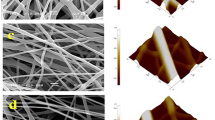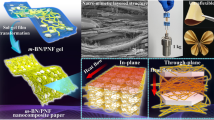Abstract
Antibacterial polyacrylonitrile (PAN) nanofibers were developed by alkaline hydrolysis and subsequent chlorination. It was shown that the hydrolyzed nanofibers could serve as an N-halamine precursor through chlorination of the amide groups obtained by partial hydrolysis of the nitrile groups. The hydrolysis conditions were optimized, so that sufficient chlorine for effective antibacterial activities could be obtained on the surfaces. The chemical and physical structural changes were well characterized with FTIR, TGA, DSC and SEM. It was found that even though the hydrolyzed nanofibers cyclized with ionic and free radical mechanisms, the chlorinated nanofibers cyclized with only free radical mechanism as evidenced by its higher onset of cyclization temperature. On the other hand, the hydrolysis and chlorination process significantly improved the mechanical properties of the nanofibers. Moreover, the chlorinated nanofibers showed potent antibacterial activities against S. aureus and E. coli with about 6 logs inactivation. The developed antibacterial PAN nanofibers possess great potential for use in various fields, medical industry in particular.







Similar content being viewed by others
References
Okeke IN, Laxminarayan R, Bhutta ZA, Duse AG, Jenkins P, O’Brien TF, Pablos-Mendez A, Klugman KP (2005) Antimicrobial resistance in developing countries. Part I: recent trends current status. Lancet Infect Dis 5(8):481–493
Balsalobre LC, Dropa M, Matte MH (2014) An overview of antimicrobial resistance and ıts public health significance. Braz J Microbiol 45(1):1–6
Chen S, Chen S, Jiang S, Xiong M, Luo J, Tang J, Ge Z (2011) Environmentally friendly antibacterial cotton textiles finished with siloxane sulfopropylbetaine. ACS Appl Mater Interfaces 3(4):1154–1162
Levy SB, Marshall B (2004) Antibacterial resistance worldwide: causes, challenges and responses. Nat Med 10:S122–S129
Boryo D (2013) The effect of microbes on textile material: a review on the way-out so far. Int J Eng Sci 2:9–13
Liu Y, Ren X, Liang J (2015) Antibacterial modification of cellulosic materials. BioResources 10(1):1964–1985
Appendini P, Hotchkiss JH (2002) Review of antimicrobial food packaging. Innov Food Sci Emerg 3(2):113–126
Kenawy E-R, Worley S, Broughton R (2007) The chemistry and applications of antimicrobial polymers: a state-of-the-art review. Biomacromol 8(5):1359–1384
Worley SD, Williams DE (1988) Halamine water disinfectants. Crit Rev Env Contr 18:133–175
Sun G, Wheatley WB, Worley SD (1994) A new cyclic N-halamine biocidal polymer. Ind Eng Chem Res 33(1):168–170
Sun G, Xu X (1999) Durable and regenerable antibacterial finishing of fabrics: chemical structures. Text Chem Color 31(5):31
Ren X, Kou L, Liang J, Worley S, Tzou Y-M, Huang T (2008) Antimicrobial efficacy and light stability of N-halamine siloxanes bound to cotton. Cellulose 15(4):593–598
Liu S, Zhao N, Rudenja S (2010) S Surface interpenetrating networks of poly(ethylene terephthalate) and polyamides for effective biocidal properties. Macromol Chem Phys 211(3):286–296
Kim SS, Kim J, Huang T, Whang HS, Lee J (2009) Antimicrobial polyethylene terephthalate (PET) treated with an aromatic N-halamine precursor, m-aramid. J Appl Polym Sci 114(6):3835–3840
Sun X, Cao Z, Porteous N, Sun Y (2012) An N-halamine-based rechargeable antimicrobial and biofilm controlling polyurethane. Acta Biomater 8(4):1498–1506
Kocer HB, Cerkez I, Worley SD, Broughton RM, Huang TS (2011) N-halamine copolymers for use in antimicrobial paints. ACS Appl Mater Interfaces 3(8):3189–3194
Bastarrachea LJ, McLandsborough LA, Peleg M, Goddard JM (2014) Antimicrobial N-halamine modified polyethylene: characterization, biocidal efficacy, regeneration, and stability. J Food Sci 79(5):E887–E897
Hui F, Debiemme-Chouvy C (2013) Antimicrobial N-halamine polymers and coatings: a review of their synthesis, characterization, and applications. Biomacromol 14(3):585–601
Liu S, Sun G (2006) Durable and regenerable biocidal polymers: acyclic N-halamine cotton cellulose. Ind Eng Chem Res 45(19):6477–6482
Ren X, Zhu C, Kou L, Worley SD, Kocer HB, Broughton RM, Huang TS (2010) Acyclic N-halamine polymeric biocidal films. J Bioact Compat Pol 25(4):392–405
Zhang L, Aboagye A, Kelkar A, Lai C, Fong H (2014) A review: carbon nanofibers from electrospun polyacrylonitrile and their applications. J Mater Sci 49(2):463–480. doi:10.1007/s10853-013-7705-y
Liu L, Liu Z, Bai H, Sun DD (2012) Concurrent filtration and solar photocatalytic disinfection/degradation using high-performance Ag/TiO2 nanofiber membrane. Water Res 46(4):1101–1112
Lin S, Cai Q, Ji J, Sui G, Yu Y, Yang X, Ma Q, Wei Y, Deng X (2008) Electrospun nanofiber reinforced and toughened composites through in situ nano-interface formation. Compos Sci Technol 68(15):3322–3329
Simitzis JC, Georgiou PC (2015) Functional group changes of polyacrylonitrile fibres during their oxidative, carbonization and electrochemical treatment. J Mater Sci 50(13):4547–4564
Huang ZM, He CL, Yang A, Zhang Y, Han XJ, Yin J, Wu Q (2006) Encapsulating drugs in biodegradable ultrafine fibers through co-axial electrospinning. J Biomed Mater Res A 77(1):169–179
Yoo HS, Kim TG, Park TG (2009) Surface-functionalized electrospun nanofibers for tissue engineering and drug delivery. Adv Drug Deliver Rev 61(12):1033–1042
Shi Q, Vitchuli N, Nowak J, Caldwell JM, Breidt F, Bourham M, Zhang X, McCord M (2011) Durable antibacterial Ag/polyacrylonitrile (Ag/PAN) hybrid nanofibers prepared by atmospheric plasma treatment and electrospinning. Eur Polym J 47(7):1402–1409
Panthi G, Park S-J, Kim T-W, Chung H-J, Hong S-T, Park M, Kim H-Y (2015) Electrospun composite nanofibers of polyacrylonitrile and Ag2CO3 nanoparticles for visible light photocatalysis and antibacterial applications. J Mater Sci 50(13):4477–4485. doi:10.1007/s10853-015-8995-z
Ren X, Akdag A, Zhu C, Kou L, Worley SD, Huang TS (2009) Electrospun polyacrylonitrile nanofibrous biomaterials. J Biomed Mater Res A 91(2):385–390
Ren X, Kocer HB, Worley SD, Broughton RM, Huang TS (2013) Biocidal nanofibers via electrospinning. J Appl Polym Sci 127(4):3192–3197
Wang L, Xie J, Gu L, Sun G (2006) Preparation of antimicrobial polyacrylonitrile fibers: blending with polyacrylonitrile-co-3-allyl-5, 5-dimethylhydantoin. Polym Bull 56(2):247–256
Wei DF, Zhou RH, Zhang YW, Guan Y, Zheng AN (2013) Acrylonitrile copolymers containing guanidine oligomer: synthesis and use for the preparation of nonleaching antimicrobial acrylic fibers. J Appl Polym Sci 130(1):419–425
Gliscinska E, Gutarowska B, Brycki B, Krucinska I (2013) Electrospun polyacrylonitrile nanofibers modified by quaternary ammonium salts. J Appl Polym Sci 128(1):767–775
Litmanovich AD, Plate NA (2000) Alkaline hydrolysis of polyacrylonitrile. On the reaction mechanism. Macromol Chem Phys 201(16):2176–2180
Lepoutre P, Hui SH, Robertson AA (1973) The water absorbency of hydrolyzed polyacrylonitrile-grafted cellulose fibers. J Appl Polym Sci 17(10):3143–3156
Zhang G, Yan H, Ji S, Liu Z (2007) Self-assembly of polyelectrolyte multilayer pervaporation membranes by a dynamic layer-by-layer technique on a hydrolyzed polyacrylonitrile ultrafiltration membrane. J Membr Sci 292(1):1–8
Castel D, Ricard A, Audebert R (1990) Swelling of anionic and cationic starch-based superabsorbents in water and saline solution. J Appl Polym Sci 39(1):11–29
Williams D, Elder E, Worley S (1988) Is free halogen necessary for disinfection? Appl Environ Microb 54(10):2583–2585
Barnes K, Liang J, Worley SD, Lee J, Broughton RM, Huang TS (2007) Modification of silica gel, cellulose, and polyurethane with a sterically hindered N-halamine moiety to produce antimicrobial activity. J Appl Polym Sci 105(4):2306–2313
Ren X, Akdag A, Kocer HB, Worley SD, Broughton RM, Huang T (2009) N-halamine-coated cotton for antimicrobial and detoxification applications. Carbohydr Polym 78(2):220–226
Ates B, Cerkez I (2017) Dual antibacterial functional regenerated cellulose fibers. J Appl Polym Sci 134:44872
Liu S, Sun G (2008) New refreshable N-halamine polymeric biocides: N-chlorination of acyclic amide grafted cellulose. Ind Eng Chem Res 48(2):613–618
Kampalanonwat P, Supaphol P (2011) Preparation of hydrolyzed electrospun polyacrylonitrile fiber mats as chelating substrates: a case study on copper (II) ions. Ind Eng Chem Res 50(21):11912–11921
Zhang G, Meng H, Ji S (2009) Hydrolysis differences of polyacrylonitrile support membrane and its influences on polyacrylonitrile-based membrane performance. Desalination 242(1–3):313–324
Deng S, Bai R, Chen JP (2003) Behaviors and mechanisms of copper adsorption on hydrolyzed polyacrylonitrile fibers. J Colloid Interface Sci 260(2):265–272
Cerkez I, Kocer HB, Worley SD, Broughton RM, Huang TS (2012) Multifunctional cotton fabric: antimicrobial and durable press. J Appl Polym Sci 124(5):4230–4238
Wu GP, Lu CX, Ling LC, Lu YG (2009) Comparative investigation on the thermal degradation and stabilization of carbon fiber precursors. Polym Bull 62(5):667–678
Chauque EF, Dlamini LN, Adelodun AA, Greyling CJ, Ngila JC (2016) Modification of electrospun polyacrylonitrile nanofibers with edta for the removal of Cd and Cr ions from water effluents. Appl Surf Sci 369:19–28
Jin SY, Kim MH, Jeong YG, Yoon YI, Park WH (2017) Effect of alkaline hydrolysis on cyclization reaction of PAN nanofibers. Mater Design 124:69–77
Cheng R, Zhou Y, Wang J, Cheng Y, Ryu S, Jin R (2013) High char-yield in an-am copolymer by acidic hydrolysis of homopolyacrylonitrile. Carbon Lett 14(1):34–39
Hajir Bahrami S, Bajaj P, Sen K (2003) Thermal behavior of acrylonitrile carboxylic acid copolymers. J Appl Polym Sci 88(3):685–698
Ji L, Medford AJ, Zhang X (2009) Electrospun polyacrylonitrile/zinc chloride composite nanofibers and their response to hydrogen sulfide. Polymer 50(2):605–612
Li R, Sun M, Jiang Z, Ren X, Huang TS (2014) N-halamine-bonded cotton fabric with antimicrobial and easy-care properties. Fiber Polym 15(2):234–240
Lin J, Winkelmann C, Worley SD, Kim J, Wei CI, Cho U, Broughton RM, Santiago JI, Williams JF (2002) Biocidal polyester. J Appl Polym Sci 85(1):177–182
Cerkez I, Sezer A, Bhullar SK (2017) Fabrication and characterization of electrospun poly (e-caprolactone) fibrous membrane with antibacterial functionality. R Soc Open Sci 4(2):160911
Acknowledgements
The authors acknowledge Dr. Mehmet Orhan for his help with the antibacterial testing.
Author information
Authors and Affiliations
Corresponding author
Ethics declarations
Conflict of interest
The authors declare that they have no competing interests.
Electronic supplementary material
Below is the link to the electronic supplementary material.
Rights and permissions
About this article
Cite this article
Aksoy, O.E., Ates, B. & Cerkez, I. Antibacterial polyacrylonitrile nanofibers produced by alkaline hydrolysis and chlorination. J Mater Sci 52, 10013–10022 (2017). https://doi.org/10.1007/s10853-017-1240-1
Received:
Accepted:
Published:
Issue Date:
DOI: https://doi.org/10.1007/s10853-017-1240-1




